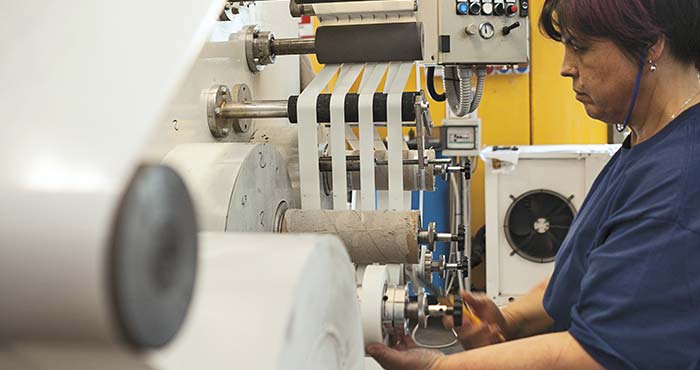
Serration Process


Serration is a process performed on flexible material that involves making small, closely spaced cuts perpendicular to the edges of the material. Starting from material wound in a roll, these short repetitive cuts are made with a depth that can vary from 2 to 10 mm and a "pitch" (i.e., distance between one cut and the next) from 1 to 2 mm.
This process is carried out to isolate the transformer coil with the conductor (copper wire) obtaining more isolated turns. This process allows for better adaptability of the material itself while still ensuring the technical characteristics of the product.
Serration on flexible material is an essential and highly specialized process used in a wide range of industries to create products with precisely and accurately cut edges on materials that have some flexibility. This process is particularly common in the textile, packaging, automotive, and electronics industries, where it is necessary to cut materials such as fabrics, plastic films, paper, rubber, and composite materials.
Execution
It can be performed using different methods and technologies, depending on the characteristics of the material to be cut and the application specifications. One of the most common methods is the use of sharp blades or rotary blades that make precise cuts along the edges of the material. These blades can be adjusted to ensure uniform cutting depth and precise finish, allowing for clean and well-defined edges.
Another common technique is the use of lasers. Lasers can be employed to make high-precision cuts on a wide range of materials, including fabrics, plastic films, and rubber. Thanks to their ability to generate a highly focused light beam, lasers can create extremely precise and clean cuts, allowing for high-quality edges without deformation or damage to the surrounding material.
Main benefits
Regardless of the method used, serration process on flexible material requires extreme precision and great attention to detail to ensure optimal results. It is essential to use high-quality equipment and tools and ensure that the process is adequately controlled and monitored to avoid defects or imperfections in the cuts.
One of the main advantages of this process on flexible material is its ability to create precisely cut edges on materials that might otherwise be difficult to work with. This process allows for complex and detailed shapes to be obtained with ease, enabling the production of high-quality finished products with reliable performance.
Furthermore, serration on flexible material offers greater flexibility and versatility in the design and production of a wide range of products. Thanks to its ability to make precise cuts on a variety of materials, this process allows for the creation of custom components and products that meet the specific needs of the application.
Another advantage of serration process is its efficiency and speed. This process allows for precise and repeatable cuts in a short time, increasing productivity and reducing overall delivery times.
In conclusion, it is an essential process for a wide range of industries and applications, allowing for precisely cut edges on materials that have some flexibility. Thanks to its ability to create precise, detailed, and repeatable cuts, this process offers numerous advantages in terms of quality, versatility, and efficiency in the production of a variety of products. With advanced equipment and technologies, this method continues to be a fundamental element in the production of high-quality products with reliable performance.

